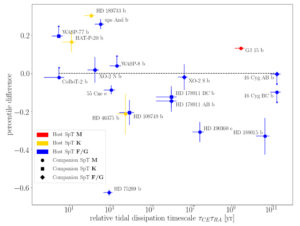Paper on tidal star-planet interaction
One of the major research questions in my group has reached a milestone – my PhD student Nikoleta Ilic led an investigation of the magnetic activity of planet-hosting stars that are located in wide multiple system with one or more other stars. Such systems allow us to test for an overactivity of the planet host star due to star-planet interaction (SPI) by using the other star(s) in the system as a negative, same-age control. Nikoleta found a significant correlation of excess stellar activity with the expected tidal interaction strength between a star and its planet. This has been very difficult to show unambiguously in previous studies because of the various biases from planet detection methods which can cause a similar trend in activity levels if not corrected for. So I am very happy that this bias-controlled sample actually shows significant SPI effects! 
Tidal star-planet interaction and its observed impact on stellar activity in planet-hosting wide binary systems
Ilic, N.; Poppenhaeger, K.; Hosseini, S. Marzieh
Tidal interaction between an exoplanet and its host star is a possible pathway to transfer angular momentum between the planetary orbit and the stellar spin. In cases where the planetary orbital period is shorter than the stellar rotation period, this may lead to angular momentum being transferred into the star’s rotation, possibly counteracting the intrinsic stellar spin-down induced by magnetic braking. Observationally, detecting altered rotational states of single, cool field stars is challenging, as precise ages for such stars are rarely available. Here we present an empirical investigation of the rotation and magnetic activity of a sample of planet-hosting stars that are accompanied by wide stellar companions. Without needing knowledge about the absolute ages of the stars, we test for relative differences in activity and rotation of the planet hosts and their co-eval companions, using X-ray observations to measure the stellar activity levels. Employing three different tidal interaction models, we find that host stars with planets that are expected to tidally interact display elevated activity levels compared to their companion stars. We also find that those activity levels agree with the observed rotational periods for the host stars along the usual rotation-activity relationships, implying that the effect is indeed caused by a tidal interaction and not a purely magnetic interaction which would be expected to affect the stellar activity, but not necessarily the rotation. We conclude that massive, close-in planets have an impact on the stellar rotational evolution, while the smaller, more distant planets do not have a significant influence.
Monthly Notices of the Royal Astronomical Society, Advance Access, April 2022